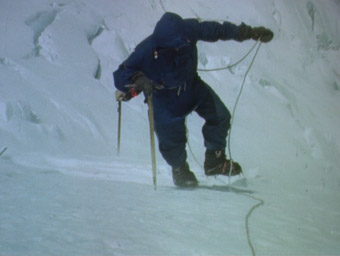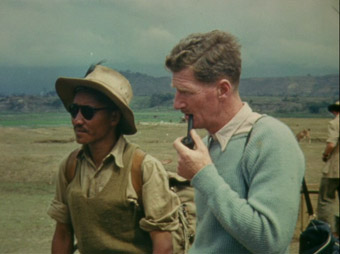|
Here's a thing. I adore mountains but am terrified of heights.
I can thus stare at a mountain range all day, marvel at
its beauty and majesty, but I'll do so from sea level or thereabouts if
that's all right by you. Just recently, I was in Italy and
went on a coach trip to gawk at the Dolomites, the country's
very own Alpine mountain range. As we approached, the views
became increasingly impressive, but the tour guide assured
us we were going to a place where we'd get a much better
look. Yeah, to the top of one of them. It was the sort of
winding, endlessly upward journey that provides you with
repeated and extended flashes of your past life and made
me wish I'd never come to Italy in the first place. Until
we reached the top, that is. The views were – and I can't
find another more creative word for this – just stunning.
Was it worth that terrifying drive up and the apprehension
of a return journey? I'd have to say it was. Would I do
it again? At a pinch, yes. Would I climb up the side of
one of them with only spiked shoes, pins, a hammer and some
rope to get me there? No bloody way.
Mountaineers
are a different breed to the rest of us. For them, it's not
about enjoying the view from the top but the climb itself,
the physical effort and endurance required get where few,
if any, have gone before. I've had friends who were rock
climbers and they could converse for hours about the difficulty
of a particular rock face, the obstacles they had to overcome,
the risks they took. Is it about proving themselves in that
particularly male manner? Perhaps a little, but then one
of those friends was female, and if you're looking to show
off your physical abilities to others then climbing with
a couple of friends up an isolated mountainside is unlikely
to fit the bill.

Climbing a mountain is
something I've never done and never really wanted to do – a fear of heights is a bit of a handicap for even the
most timid mountaineer – but I do understand its appeal.
It represents an adventure, a risk, an exploration in a
world in which such activities are limited and often corporate
managed. The definitive reason, the one that has provided
mountaineers of all ages with their credo, was supplied
back in March of 1923 by George Mallory when he famously responded
to reporters' questions about why he wanted to climb Mount Everest: "Because
it's there." Of course, Mallory wasn't talking about
just any mountain, but the one that represented the greatest
mountaineering goal of the time, the highest peak on the
face of the planet Earth. A year
later, on his third expedition to this very mountain, Mallory
disappeared. His last recorded sighting was just a few hundred
metres from the summit. It was to be another 75 years before
his body was found.
Once
the obsession of a dedicated few, mountaineering has in
recent years expanded its user base considerably. Consider
these figures for Mount Everest alone. In 1970 just four
climbers reached the summit, in 1980 there were ten, in 1990
there were seventy-two, and in 2000 one hundred and forty-six hardy souls made their way
to the top. By the end of 2006 there had been a total of
three thousand and fifty successful ascents to the summit of this mountain alone.
Even
armed with the knowledge from so many previous climbs and
dramatically improved equipment and support, any assault
on Everest is not a challenge for the timid or ill-prepared – to date, over two hundred climbers have died in the attempt. But
spare a thought for the pioneers, those who ventured into
the unknown with equipment that modern climbers would balk
at, when access to the mountain was restricted to a single
expedition per year and sometimes not even that. In 1953, that slot was taken
by a British team led by John Hunt and included in its
number the original expedition leader Eric Shipton, climbers
Tom Bourdillon, Charles Evans, George Lowe and Edmund Hillary,
and Sherpa mountaineer Tenzing Norgay. You don't have to
be part of the climbing fraternity to know how this ended – Hillary and Tenzing went into the history books as the
first men to successfully reach the summit of the world's
highest mountain. (It's one of those nice little ironies
that despite the expedition's British identity, it was a
Sherpa and a New Zealander who actually set foot on the
mountaintop).
Happily
for posterity, expedition member George Lowe chose to add
considerably to his carrying weight (or rather that of the
Sherpas employed to haul the group's supplies) by taking
a 35mm movie camera and a stock of colour film along
with him. On his return, the footage was edited, a score
commissioned, and a narration was written and recorded. The result
was The Conquest of Everest, a very British,
very 1950s, but still captivating record of a landmark achievement
and one of the key events in mountaineering history.

Part
of the film's fascination in a time of high-tech mountaineering
is its record of the equipment the 1953 team had to work
with, some of which, such as the tie-on crampons and Heath
Robinson oxygen tank support cradles, look almost home-built.
The image of old school British explorers out for a bit
of an adventure is momentarily suggested by the sight of
a pipe-smoking mountaineer in knee-length shorts, but it
soon becomes clear just how professional the climbers were and how
carefully and thoroughly they had planned
their expedition. Their only real stumbling block proves an underestimation
of the full effects of oxygen deprivation, which is understandable
given that no-one had ever climbed to and returned from
that height before.
A
sometimes heroic commentary, written by Louis MacNeice and
spoken by actor Meredith Edwards ("What they are carrying
also" he says of the heavy packs hauled by the Sherpas,
"is a dream that is turning ripe"), a dramatic
and emotive score by Arthur Benjamin, and some unsubtle sound
effects (the wind is never less than deafening) nonetheless
drive the film forward and communicate very effectively
the experience and difficulties of the climb. Useful information
on the route is provided by John Hunt, with Hillary giving
a matter-of-fact description of his and Tensing's arrival
at the summit, a key moment somewhat inevitably missed by
Lowe's camera, although the reunion with their waiting colleagues
strikes a suitably triumphant note.
Lowe's
colour cinematography is often striking. This is no mountaineer-with-a-camcorder
imagery, but carefully composed and sometimes arresting
footage that captures both the beauty and the danger of
the landscape. The scale of the party's task, already made
to look impossible by a graphical sequence comparing Everest
to St. Paul's Cathedral, is wonderfully illustrated by a
seemingly endless tilt up from the small figures of the
walking mountaineers to the towering height of the mountain's
peak. But Lowe also captures faces and activity of the
party and the local people, never forgetting that the mountain, for all its magnificence, is the setting rather
than the star.
An
as-it-happened documentary of the old school, shot silent
with sound effects and narration added later, Conquest
of Everest is going to feel dated to those who
have come to documentary features via the more aurally and
visually busy works of recent years. But like Thor Heyerdahl's
similarly styled Kon-Tiki,
it works precisely because it's all about the story, not
the manner of its telling.
Framed
1.33:1, as near as dammit to its apparent original ratio
of 1.37:1, dust spots and the occasional scratch are almost
inevitable for a documentary work of this period – the surprise
is how unobtrusive they are and how good the picture looks
otherwise. Detail is a touch soft on some of wider shots
but elsewhere is very good, and the contrast is just right.
The colour reproduction varies a little, being a touch muted in
places but when the prime colours are on display, as in
the opening coronation footage, the Technicolor print is
vibrant.
The
Dolby 2.0 mono soundtrack shows its age a little, mainly
in the music, which lacks full bodied punch of a more modern
track and occasionally gets a little wobbly. The narration
is always clear, though, and the soundtrack itself is free
of crackle.
None.
A bit of a shame, this, as there must be plenty of scope
for the inclusion of textual features about the mountain
and/or the expedition, archive footage of previous expeditions
(a short extract is included in the film) and a retrospective
documentary looking at the significance of the team's achievement.
Just a thought.
Invaluable as a historical document, Conquest of
Everest also holds its own as a straight documentary,
and I do mean straight – there's no postmodernist tomfoolery
at work here. Mountaineers and documentary enthusiasts will
already have this on their shopping list – a shame about
the lack of extra features, as a little work in this area
might have seen the disc reached a larger audience.
|